International Harvester Company

The International Harvester Company (often abbreviated by IHC, IH, or simply International (colloq.)) was an American manufacturer of agricultural and construction equipment, automobiles, commercial trucks, lawn and garden products, household equipment, and more. It was formed from the 1902 merger of McCormick Harvesting Machine Company and Deering Harvester Company and three smaller manufactures: Milwaukee; Plano; and Warder, Bushnell, and Glessner (manufacturers of Champion brand). Its brands included McCormick, Deering, and later McCormick-Deering, as well as International. Along with the Farmall and Cub Cadet tractors, International was also known for the Scout and Travelall vehicle nameplates. In the 1980s all divisions were sold off except for International Trucks, which changed its parent company name to Navistar International (NYSE: NAV).
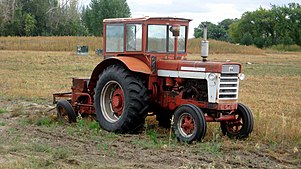 International 660 in rural Saskatchewan
International 660 in rural Saskatchewan
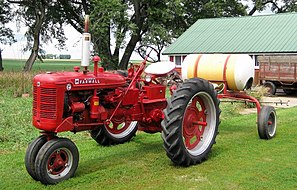
A 1954 IH Farmall Super C
Given its monumental importance to the building of rural communities the brand continues to have a massive cult following. The International Harvester legacy non-profits host some of the largest agriculture related events in the United States.
Following years of financial and economic decline, International began selling its separate equipment divisions, starting with the sale of the construction division to Dresser Industries in 1982. In November 1984 IH finalized a deal with Tenneco to sell the farm equipment division to Tenneco's subsidiary Case Corporation, and the brand continues as Case IH which is owned by CNH. The European division exists today as McCormick Tractors and is owned by ARGO SpA of Italy. International became solely a truck and engine manufacturer and reorganized as Navistar International in 1986. Throughout its existence International Harvester was headquartered in Chicago, Illinois. In 2020 Volkswagen agreed to fully purchase the remaining shares of Navistar.
History

Cyrus Hall McCormick patented an early mechanical reaper.
The roots of International Harvester run to the 1830s, when Virginia inventor Cyrus Hall McCormick perfected his version of a horse-drawn reaper, which he field-demonstrated in 1831 and for which he received a patent in 1834. Together with his brother Leander J. McCormick, he moved to Chicago in 1847 to be closer to the Midwestern grain fields and founded the McCormick Harvesting Machine Company. The reaper sold well, partially as a result of savvy and innovative business practices. Their products came onto the market just as the development of railroads offered wide distribution to distant territories. He developed a vast support network to demonstrate field operations. McCormick died in 1884 and his company passed to his son, Cyrus McCormick, Jr., whose antipathy and incompetence toward organized labor sparked the Haymarket affair, the origin of May Day as a labor holiday.

1900 ad for McCormick farm machines--your boy can operate them
In 1902, the McCormick Harvesting Machine Company and Deering Harvester Company, along with three smaller agricultural equipment firms (Milwaukee Harvesting Machine Co., Plano Manufacturing Co., and Warder, Bushnell, and Glessner—manufacturers of Champion brand) merged to create the International Harvester Company. Banker J.P. Morgan provided the financing. The architect of the merger was George W. Perkins, one of the Morgan executives about whom Cyrus McCormick described as the "most brilliant negotiator he had ever known." The new company was valued at $150 million. In 1919, IH bought the Parlin and Orendorff factory in Canton, Illinois, a leader in plow manufacturing, renaming it Canton Works. International Harvester was one of the main clients of Product Miniature Company.
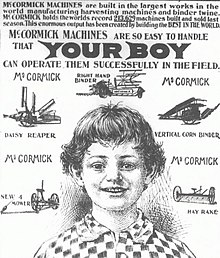
Advertisement for the 1940 International Tanker Truck
Sustained success[edit]
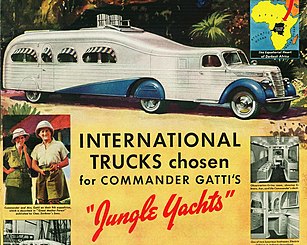 1939 advertisement for the International "Jungle Yacht" tractor-trailer, for Attilio Gatti's luxury scientific expedition in the Belgian Congo
In 1926, IH's Farmall Works built a new plant in Rock Island, Illinois. By 1930, the 100,000th Farmall was produced. IH next set their sights on introducing a true 'general-purpose' tractor to satisfy the needs of the average American family farmer. The resulting 'letter' series of Raymond Loewy-designed Farmall tractors in 1939 proved a huge success. IH dominated the market through the 1950s despite stiff competition from Ford, Allis Chalmers, Massey Ferguson and John Deere.
1939 advertisement for the International "Jungle Yacht" tractor-trailer, for Attilio Gatti's luxury scientific expedition in the Belgian Congo
In 1926, IH's Farmall Works built a new plant in Rock Island, Illinois. By 1930, the 100,000th Farmall was produced. IH next set their sights on introducing a true 'general-purpose' tractor to satisfy the needs of the average American family farmer. The resulting 'letter' series of Raymond Loewy-designed Farmall tractors in 1939 proved a huge success. IH dominated the market through the 1950s despite stiff competition from Ford, Allis Chalmers, Massey Ferguson and John Deere.
IH ranked 33rd among United States corporations in the value of World War II production contracts. In 1946 IH acquired a defense plant in Louisville, Kentucky, which was adapted for production of the Farmall A, B, and the new 340 tractors. It acquired the Metropolitan Body Company of Bridgeport, Connecticut, in 1948. The commercially successful Metro line of forward control vans and trucks were produced here from 1938 until 1964.
In 1970, Pacific Trucks was purchased. In 1974, the five-millionth IHC tractor was produced at the Rock Island Farmall plant.
Throughout the 1960s and 1970s, despite good sales, IH's profit margins remained slim. The continual addition of unrelated business lines created a somewhat unwieldy corporate organization. Overly conservative management and a rigid policy of in-house promotion tended to stifle new management strategies and technical innovation. IH faced strong competition and increased production costs, primarily due to labor and government-imposed environmental and safety regulations. In 1974 the 5 millionth International Harvester tractor, a 1066, was manufactured.
Downfall
In 1979 IH named a new CEO, Archie McCardell, who was determined to improve profit margins and drastically cut costs. Unprofitable lines were terminated and factory production was curtailed. By the end of the year, profits were at their highest levels in 10 years but cash reserves were still low. Union members became increasingly irate over these measures and in the spring of 1979, IH prepared to face a strike. On November 1, IH announced McCardell had received a $1.8 million bonus. After he pressed for more concessions from the United Auto Workers, a strike was called on November 2, 1979. By the time it ended, the strike had cost the company almost $600 million (over $2 billion today).
By 1981, the company's finances were at their lowest point ever. The company sold its Payline division of construction equipment to Dresser Industries in 1982. Further assets were sold to Tenneco, Inc., in 1984.
Following the merger, tractor production at Farmall Works ceased in 1985. Production of the new Case IH tractors moved to J.I. Case in Racine, Wisconsin. Production of IH Axial-Flow combines continued at the East Moline, Illinois, factory. The Memphis Works plant was closed.[citation needed] The truck and engine divisions remained and in 1986, Harvester changed the corporate name to Navistar International Corporation, having sold the International Harvester name to Tenneco. Navistar International Corporation continues to manufacture medium- and heavy-duty trucks, school buses, and engines under the International brand name.
Divisions and products
Agriculture Division
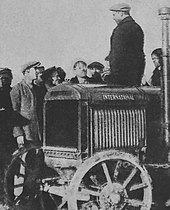
McCormick-Deering 15–30 on the fields of the Ukrainian SSR in 1930
The International Harvester Agricultural Division may have been second to the Truck Division but it was the best-known subsidiary. One of its early products was the Traction Truck, a frame manufactured by Morton Traction Truck Company (later bought by IHC) featuring an IHC engine.
From 1902 to the early 1920s, the McCormick and Deering dealerships kept their original branding with Mogul tractors sold by McCormick and Titan tractors at Deering due to the still-present competitiveness of the former rivals.

An International Harvester Type A tractor, manufactured from 1908 to 1913
The early tractors[edit]
IH produced a range of large gasoline-powered farm tractors under the Mogul and Titan brands. Sold by McCormick dealers, the Type C Mogul was little more than a stationary engine on a tractor chassis, fitted with friction drive (one speed forward, one reverse).[11] Between 1911 and 1914, 862 were built.[11] These tractors had varied success but the trend going into the mid-1910s was toward "small" and "cheap".
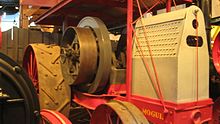
A 1911 one-cylinder 25 hp (19 kW) Type C Mogul
The company's first important tractors were the 10-20 and 15-30 models. Introduced in 1915, they were primarily used as traction engines to pull plows and for belt work on threshing machines. The 10-20 and 15-30 had similar Mogul and Titan versions.
Concurrently, IHC purchased a number of smaller competitors. Parlin & Orendorff (P&O Plow) and Chattanooga Plow were purchased in 1919. Other brand names they incorporated include Keystone, D.M. Osborne, Kemp, Meadows, Sterling, Weber, Plano, and Champion.
In 1924 IH introduced the Farmall, a smaller general-purpose tractor, to fend off competition from Ford Motor Company's Fordson tractors. Farmall was a leader in the emerging row-crop tractor segment.
,_Bangor,_ME_IMG_2515.jpg)
A 1937 McCormick-Deering Farmall F-12 tractor on display at the Cole Land Transportation Museum[12] in Bangor, Maine
Following the introduction of Farmall, several similarly styled "F Series" models were introduced while the original design continued to be produced as the "Regular."
In 1932, IH produced their first diesel engine for the McCormick-Deering TD-40 crawler. This engine would start on gasoline and then switch to diesel. Other diesel engines of this era were difficult to start in cold weather and using gasoline allowed the engine to thoroughly warm up first. In 1935, it was used in the WD-40, becoming the first diesel tractor on wheels in North America[13] (the world's first diesel tractor was Germany's Benz-Sendling BS 6 in 1922).
Heavy tractors[edit]
The market for industrial tractors grew in the 1930s. The TD-40, the first of IH's heavy-equipment crawlers, was suited for a wide range of environments. As demand for construction equipment grew, so did the competition. The diversification of the agricultural tractor range into genuine construction equipment whetted appetites for further expansion. In 1937 IH engaged designer Raymond Loewy to revamp its product line and logo. In 1938 the first such model was the TD-65 heavy tractor, later renamed the TD-18.[14]
The letter and standard series[edit]

A McCormick Farmall H
For model year 1939, Raymond Loewy created the Farmall "letter series" (A, B, BN, C, H, and M) and the McCormick-Deering "standard series" (W-4, W-6, and W-9).[15] For 1941 the MD model was introduced as the first row crop diesel-powered tractor; over a decade later, IH's largest competitor, John Deere, introduced a diesel option on their row crop models. The letter series tractors were updated to the "super" series in 1953 (with the exception of the A, which had become a "super" in 1947, and the B and BN, which were discontinued in 1948). Many of these tractors (especially the largest, the H, M, and W models) are still in operation on farms today. Especially desirable are the diesel-powered MD, WD-6, and WD-9's.
The letter and standard series of tractors was produced until 1954 and was a defining product in IH history.
In 1947, the smallest tractor in the Farmall line was introduced, the Cub. With a 60-cu. in., four-cylinder engine and a 69-inch wheelbase, the Cub was aimed at small farms which had previously relied on horse-drawn equipment. Like the various John Deere L/LA/LI models, one of the "mechanization-resistant" markets it hoped to penetrate was the small one-mule family farms of the rural American Deep South, but the Cub also sold to owners of larger farms needing a second tractor. Production of the Cub commenced at the newly acquired and updated Farmall Works-Louisville plant (formerly the wartime Curtiss-Wright Aircraft factory in Louisville, Kentucky). Selling for $545 in 1947, the Cub proved extremely popular and its design continued largely unchanged mechanically until 1979.
For 1955 in IH tractors, the numbered "hundred series" was offered. Although given slightly different styling and few new features, they were still updates to the models introduced in 1939. The only new tractor in the 1955 lineup was the 300 Utility. In 1957 power was increased in some models and the 230 Utility was introduced.
Heavy tractors: the 1950s
IH would sell 38,000 TD-18 series tractors between 1938 and 1958. The TD-18 would be replaced by an upgraded TD-18A in 1949 and 181/182 variants in 1955. In 1958 the TD-20 crawler was introduced.
60 Series recall
In July 1958, IH launched a major campaign to introduce a new line of tractors, the 60 series. At the Hinsdale, Illinois, Testing Farm, IH entertained over 12,000 dealers from over 25 countries. The series included the first-of-its-kind six-cylinder 460 and 560 tractors. Unfortunately just a year later, these models were recalled due to final drive component failures. They had not been updated since 1939 and would fail rapidly under the stress of the more powerful 60-series engines. Some customers lost faith in IH and migrated to John Deere's New Generation of Power tractors introduced in 1960.
1960s[edit]
.jpg)
The originally British-built International B275 model still in production in India and built by Mahindra and Mahindra
Throughout the 1960s, IH introduced new tractors and new sales techniques. As producing tractors was the lifeblood of the company, IH would have to remain competitive in this field. They both succeeded and failed at this goal but farming was about to change. In 1963, IH introduced the 73 hp (54 kW) 706 and 95 hp (71 kW) 806 tractors. Until the 88 series, all numbered seies tractors followed a simple numbering system. The first 2-3 digits was the horsepower rating, and the last number was the number of cylinders, so a 1486 was rated 148 hp and had a 6 cyl. engine, while the 1468 had 146 hp and a v8 engine. In 1964, IH made its four-millionth tractor, an 806. In 1965, IH introduced its first 100 hp (75 kW) two-wheel-drive tractor, the 1206. Another option became available in 1965 for the 706, 806, and the new 1206: a factory-installed cab (made by Stopler Allen Co.), often called the "ice cream box" due to its shape. It could be equipped with a fan and heater. By 1967, over 100,000 models 706, 806, and 1206 were built. The 276 was also built at this time, becoming popular for smaller farms with tighter lanes and fields due to its lighter weight.
In 1967 was the introduction of the bigger and more powerful 56 series tractors as replacements for the popular "06" series. These new models included the 65 hp (48 kW) 656, 76 hp (57 kW) 756, the 101 hp (75 kW) 856, and the 116 hp (87 kW) 1256. The "ice cream box" cab was still an option. In 1969 IH introduced the 1456 Turbo at 131 hp (98 kW). Also that year, the 91 hp (68 kW) 826 was introduced with the option of gearshift or hydrostatic transmissions. The "ice cream box" cab was dropped and replaced with a new "custom" cab made by Exel Industries which could be equipped with factory air-conditioning, heat, and an AM radio. Another milestone was the 1970 introduction of the 1026 Hydro, basically a hydrostatic version of the 1256 and at that time the most powerful hydrostatic transmission tractor made in the US with 114 hp (85 kW).
1970s[edit]
In 1971, IH introduced the 66 series line. The new models included the 85 hp (63 kW) 766, the 101 hp (75 kW) 966, the 125 hp (93 kW) 1066 turbo, the 145 hp (108 kW) 1466 Turbo, and the 145 hp (108 kW) 1468 V-8. The 130 hp (97 kW) 4166 4WD was also introduced. The 966 and 1066 were available with Hydro or gearshift transmissions and the choice of two-post roll over protection structures (ROPs) or two different cabs, the "custom" and the "deluxe". Both could be equipped with air conditioning, heat, and AM-FM radios.
In 1972, the 666 replaced the long-running 656, the 150 hp (110 kW) 1568 V-8 replaced the 1468, and the 160 hp (120 kW) 1566 and the 163 hp (122 kW) 4366 4WD were introduced. Also later that year, four-post ROPs replaced two-post; the "custom" cab was dropped and the "deluxe" cab was now painted red instead of white. Due to horsepower confusions, the 966 and 1066 Hydro models were restriped; the Hydro 100 and the 666 Hydro became the Hydro 70. On February 1, 1974, at 9:00 am, the five-millionth tractor came off the assembly line at the Farmall Plant in Illinois. IH was the first tractor manufacturer to accomplish this.[16] Also in 1973, IH officially dropped the "Farmall" name from its tractor. This ended an era that began with the first Farmall "Regular" back in 1924.
The 230 hp (170 kW) 4568 V-8 4WD was introduced in 1975. In 1976, the entire tractor line got a new paint job and decal pattern. No longer were the side panels all white with chrome and black decals: they were now all red with a black-striped sticker. This was done to clear inventory for the forthcoming Pro Ag Line.
In September 1976, IH released their 86 series Pro Ag Line. The models included the 80 hp (60 kW) 786, the 90 hp (67 kW) 886, the 101 hp (75 kW) 986, the 104 hp (78 kW) 186 Hydro, the 135 hp (101 kW) 1086, the 146 hp (109 kW) 1486 and the 161 hp (120 kW) 1586. These new tractors had a new cab dubbed the Control Center that came standard with air conditioning, heat, and several radio-CB options. The driver sat well ahead of the rear axle and the fuel tank was mounted behind the cab over the rear axle. This increased balance and ride. Also in 1976, the 62 hp (46 kW) 686 along with the "86" series four-wheel-drives were introduced, including the 4186, 4386, 4586, and 4786.
In 1977, International Harvester introduced the first Axial-Flow rotary combine. This machine, produced at East Moline, Illinois, was the first generation of over 30 years of Axial-Flow combines.
In 1979, IH introduced two all-new tractors: the 3388 and 3588, known as the 2+2 4WD line. These tractors were the result of taking two 1086 rear ends and hooking them together with a transfer case. A year later, the 3788 was introduced. Although these tractors performed well in the field, they never sold well.
1980s[edit]
As the 1980s began, IH faced a stable economy, yet an unknown fate. In September 1981, IH announced at a dealership meeting the new "50 Series" of tractors, which included the 136 hp (101 kW) 5088, the 162 hp (121 kW) 5288 and the 187 hp (139 kW) 5488. IH also released the "30 series", which included the 81 hp (60 kW) 3088, the 90 hp (67 kW) 3288, the 112 hp (84 kW) 3488 Hydro, and the 113 hp (84 kW) 3688. These new tractors proved once again that IH was innovative. Designed and styled by IH industrial designer Gregg Montgomery (Montgomery Design International), the new stylish design of the 50 and 30 series changed the look of tractors from that time forward. IH spent over $29 million to develop this new series, and the result was the last great lineup of tractors from International Harvester.
Many technology-related innovations were used in the new series. A computer monitoring system (Sentry) was developed, and IH became the first manufacturer to add a computer to a farm tractor. Other innovations included a "Z" shift pattern, an 18-speed synchronized transmission, a forward air-flow cooling system which sucked air from above the hood and blew it out the front grille, "Power Priority" three-pump hydraulic system, color-coded hydraulic lines and controls, and a new rear-hitch system. The 50 Series had an unprecedented three-year or 2,500-hour engine and drive-train warranty, which later became an industry standard. Although no new sales records were set, IH sold a respectable number of these tractors during their short production time. IH also released the "60 series 2+2s" and planned on making the "Super 70 series" 2+2s, but only a handful of these exist today. On May 14, 1985, the last IH tractor rolled off the factory line, a 5488 FWA.
In the late 1970s, IH entered a deal with Spain's Enasa to build diesel engines there as Internacional de Motores. After a downturn in the market coupled to problems with Spain's entry into the European Economic Community threatened the profitability of this project, International Harvester withdrew in 1982.[18] In return for being allowed to escape all conditions of the joint venture, IH lost their up-front investment in the engine plant and ended up selling British truck manufacturer Seddon Atkinson (which had belonged to IH since 1974) to Enasa in 1983.
Brand names of the agriculture division

McCormick Deering tractor
IH over the years used a number of brand names to market their tractor and harvesting products:
- International (1902–1985)
- Titan (1910–1924)
- Mogul (1911–1924)
- McCormick–Deering (1922–1947)
- McCormick (1947–1958)
- Farmall (1924–1973)
- Fairway (1924–1938)
- Electrall (1954–1956)
- Cub (1947-1985)
Other agricultural products[edit]
Along with the prominent tractor division, IH also sold several different types of farm-related equipment, such as balers, cultivators, combines (self-propelled and pull behind), combine heads, corn shellers, cotton pickers, manure spreaders, hay rakes, crop dusters, disk harrows, elevators, feed grinders, hammer mills, hay conditioners, milking machines, planters, mills, discs, plows, and miscellaneous equipment.[19]
Also produced were twine, stationary engines and wagons.[19]
Earthmoving division[edit]
IH built up its earthmoving division over a period of time, buying companies and acquiring technology. Its heavy tractor range was an established offering, however IH wanted to offer innovative new construction technology. Significant moves included the purchase of the Frank G Hough company [20] which produced an iconic machine called a PayLoader,[21] and the purchase of French company Yumbo, which produced hydraulic excavators.[22]
Between 1956 and 1982 IH developed and sold a range of off-road dump trucks, which were known commercially as 'PayHaulers'.
International manufactured and sold an extensive range of heavy equipment. In 1974 IH renamed this division the 'Payline' division.
Payloaders[edit]
The original payloader model was literally a tractor which had forks welded to the front. Frank Hough was the man who invented the concept and Hough's company worked closely with IH until it was purchased in 1952. The terminology came to mean any type of front loader machine, and loaders were manufactured in a number of varieties, included wheeled and track loaders, rear wheel loaders or an articulated steering design.[20]
PayScrapers[edit]
In the early 1950s contractors worldwide began using motor scrapers as a means of shifting dirt. IH had a hole in its product range; it did not offer a motor scraper product to the market. One of IH's suppliers, a company named Heil Earthmovers, manufactured a range of scrapers called 'Heiliners.'[23]
Rather than spend money on R&D and enter the market at a later date, in 1953 IH bought Heil's road machinery division, incorporating a range of motor and towed scrapers.[24]
Attachments: blades, buckets, rippers and compaction equipment[edit]
IH International had a supply agreement for its heavy tractor attachments with a company called Bucyrus-Erie. Amongst a variety of attachment solutions Bucyrus-Erie made a range of cable and hydraulically operated blades which fitted International-Harvester track type tractors.
IH purchased the blades range from Bucyrus-Erie in the 1950s and absorbed these into its machinery division.[25]
IH also purchased attachments for the tractor range from Isaacson, including logging arches and dozer blades.[26] Carrying on with its expansion IH purchased Isaacson's attachments division in 1952.[25]
Electrall[edit]
The Electrall system was introduced in 1954; it was a short-lived attempt to market electrically operated farm equipment and accessories. The system, co-developed with General Electric, consisted of a 208 V three-phase alternating-current generator connected with electric cables to the device to be powered. The generator could even power a household. A 10 kW Electrall generator was an option on the Farmall 400 tractor,[27] and a 12.5 kW PTO-driven version was made. The possible applications of Electrall power were many, but few made it to market. IH marketing materials showed a haybaler being Electrall powered. One of the more novel applications of the Electrall was a device to electrocute insects in the field at night (basically like a modern-day bug zapper, but on a larger scale).[28]
Road vehicles[edit]
Light duty trucks[edit]
IH is often remembered as a maker of relatively successful and innovative "light" lines of vehicles, competing directly against the Big Three. The most common were pickup trucks. IH made light trucks from 1907 to 1975, beginning with the Model A Auto Wagon (sometimes called the "Auto Buggy").[29] Production commenced in February 1907 at IH's McCormick Works in Chicago, although production was moved to Akron, Ohio, in October that year.[29] Powered by a horizontally opposed, air-cooled twin around 15 hp (11 kW), it was a right-hand-drive model popular in rural areas for high ground clearance on the poor roads typical of the era. It featured a rear seat convertible to a carrier bed.[30] The Auto Wagon was renamed the Motor Truck in 1910, and was a forerunner to the successful modern pickup truck. They were called IHC until 1914, when the 'International' name was first applied.[29] The final light line truck was made on May 5, 1975.
Following the early success with the Auto Buggy, International released their K and KB series trucks in the mid-1940s. They were more simplistic than other trucks released in that era. This was followed by the L Series in 1949, which was replaced by the R Series in 1952, followed by the S line (a name re-used later for IH's larger medium-duty trucks) in 1955. In 1957, to celebrate IH's golden anniversary as a truck manufacturer, this was replaced by the new A line. 'A' stands for anniversary. With light modifications to its appearance, but more serious changes under the shell (and a number of new names), this design continued in production until replaced by the 1100D in late 1969, which looked very similar to the Scout which was already in production.[31]
Corresponding with the truck "letter lines" was the Metro line of step (delivery) vans. Starting in 1938 and manufactured through 1975, the Metro series was produced and updated with each iteration of IH's truck lines. Also, special-use variants were sold, such as the Metro Coach (a bus version with windows and passenger seats) and Metro front-end section and chassis for full commercial customization. Additional variants were based on the medium-duty engine and chassis lines.[32]
IH abandoned sales of passenger vehicles in 1980 to concentrate on commercial trucks and school buses.
The Scout and Light Truck parts business was sold to Scout/Light Line Distributors, Inc. in 1991.

1911 International Harvester Auto Wagon (High wheeler)

International Harvester Auto-Buggy
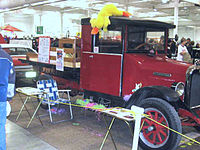
1927 International one-ton stakebed











,_Bangor,_ME_IMG_2515.jpg)

.jpg)



